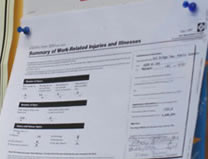- Home
- Public Employees Occupational Safety and Health
- PEOSH Health Standards
- PEOSH Recording and Reporting Occupational Injuries and Illness Standard (29 CFR 1904)
PEOSH Recording and Reporting Occupational Injuries and Illness Standard (29 CFR 1904)
The Public Employees Occupational Safety and Health (PEOSH) Act requires covered employers to “make, keep, preserve and make available the following records to the Commissioner of Labor and the Commissioner of Health:”
“b. Records regarding work-related deaths, injuries, and illnesses other than minor injuries which require only first aid treatment and which do not involve medical treatment, loss of consciousness, restriction of work or of motion, or transfer to another job.”
The PEOSH Act along with recordkeeping regulations adopted from federal OSHA (29 CFR 1904), provide specific recording and reporting requirements which comprise the framework for the statewide public sector employer recording system.
Under this system, it is essential that data recorded by employers be uniform and accurate to assure the consistency and validity of the statistical data which is used by PEOSH and OSHA for many purposes, including inspection targeting, performance measurement. The data also aid employers, employees and compliance officers in analyzing the safety and health environment at the employer's establishment and preparing the U.S. Bureau of Labor Statistics' (BLS) Annual Survey.
The text of the current PEOSH Standard on Recording and Reporting Occupational Injuries and Illness resides on the federal OSHA website and should be read with the published NJ exceptions in mind:
- All references to the Secretary of Labor shall be deemed to mean the Commissioner of Labor of the NJ Department of Labor.
- All references to OSHA shall be deemed to mean the New Jersey Department of Labor, Division of Public Safety and Occupational Safety and Health, Office of Public Employees Occupational Safety and Health (PEOSH).
- All references to OSHA forms 300, 300A and 301 shall be deemed to mean New Jersey Occupational Safety and Health (NJOSH) forms 300, 300A and 301.
- 29 C.F.R. 1904 Subpart B-Scope: New Jersey requires ALL public employers to record and report work-related deaths, injuries or illnesses as contained in this chapter.
- 29 C.F.R. 1904.1, Partial exemption for employers with 10 or fewer employees does not apply to any New Jersey Public Employer as defined in N.J.S.A. 34:6A-7(c).
- 29 C.F.R. 1904.2, Partial exemption for establishments in certain industries, does not apply to any New Jersey Public Employer as defined in N.J.A.C. 12:110-2; and
- 7. 29 C.F.R. 1904.39: Reporting fatalities and multiple hospitalization incidents must be reported to the Office of Public Employees Occupational Safety and Health (OPEOSH) via the 24-hour hotline number (800) 624-1644, the 24-hour fax line (609) 292-3749, or in person to the OPEOSH at 225 East State Street, 8th Floor West, Trenton, NJ 08625 within eight hours of the occurrence.
- Guide for Recording and Reporting of Occupational Injuries and Illnesses. This is the primary PEOSH resource available to assist NJ public sector employers in complying with the requirements of the PEOSH Recordkeeping Standard. This guidance document specifically addresses recordkeeping requirements for New Jersey public sector employers. It incorporates the major requirements of OSHA's federal recordkeeping standard as adopted by PEOSH along with the exceptions which apply to New Jersey public sector employers alone.
- Forms: Excel spreadsheet contains all three forms (click on appropriate tab at bottom of the screen). If using PDF, you may photocopy and use as many as you need.
| Form Name | Instructions | File | Description |
|
NJOSH 300 Log of Work-Related Injuries and Illnesses |
How to fill out |
[pdf 194k] [excel] |
NJOSH 300 is used to classify work-related injuries and illnesses and to note the extent and severity of each case. Employers must keep a log for each establishment or site. When an incident occurs, use the NJOSH 300 Log to record specific details about what happened and how it happened. |
| NJOSH 300A Summary of Work-Related Injuries and Illnesses | How to fill out | [pdf 23k] [excel] |
NJOSH 300A shows the totals for the categories on the NJOSH 300 log for each year along with information about the hours worked and number of employees at the establishment or site. The log must be posted in a visible location from February 1 through April 30 each year. |
| NJOSH 301 Injuries and Illnesses Incident Report | How to fill out | [pdf 69k] [excel] |
NJOSH 301 or an equivalent must be filled within 7 calendar days after you receive information that a recordable work-related injury or illness has occurred. Some state workers’ compensation, insurance or other reports may be acceptable substitutes. To be considered an equivalent form, any substitute must contain all the information asked for on this form. |
- Other Federal OSHA Compliance Assistance Materials
OSHA Recordkeeping Handbook - contains the text of the federal OSHA recordkeeping standard (without the NJ exceptions), along with interpretations of the standard and some frequently-asked questions.
Interpretations - In enforcing the standard, PEOSH also uses the official "interpretations" about the Recordkeeping Standard which have been developed by federal OSHA in response to questions from employers and employees.
Hearing Loss Chart - This document is a decision tree to help determine whether the results of an audiometric exam reveal a standard threshold shift.

- Frequently Asked Questions About OSHA's Injury and Illness Recordkeeping Rule
This document provides general guidance about OSHA's revised recordkeeping rule and provides links to more detailed guidance. The questions and answers in the Additional guidance portion of this document do not themselves impose enforceable recordkeeping or reporting obligations; such obligations are imposed only by the regulation. This version was last updated on [11/21/01].


